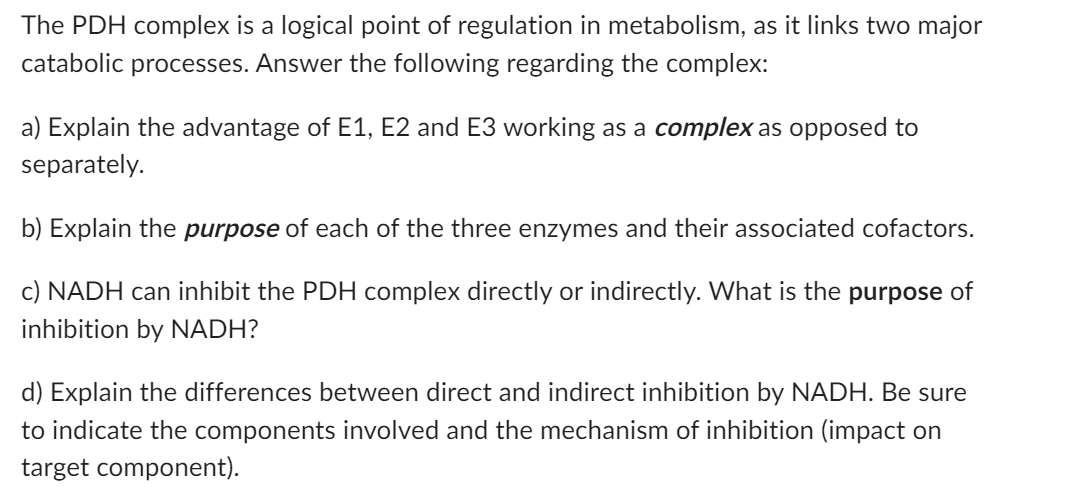The PDH complex is a logical point of regulation in metabolism, as it links two major catabolic processes. Answer the following regarding the complex: a) Explain the advantage of E1, E2 and E3 working as a complex as opposed to separately. b) Explain the purpose of each of the three enzymes and their associated cofactors. c) NADH can inhibit the PDH complex directly or indirectly. What is the purpose of inhibition by NADH? d) Explain the differences between direct and indirect inhibition by NADH. Be sure to indicate the components involved and the mechanism of inhibition (impact on target component).
The PDH complex is a logical point of regulation in metabolism, as it links two major catabolic processes. Answer the following regarding the complex: a) Explain the advantage of E1, E2 and E3 working as a complex as opposed to separately. b) Explain the purpose of each of the three enzymes and their associated cofactors. c) NADH can inhibit the PDH complex directly or indirectly. What is the purpose of inhibition by NADH? d) Explain the differences between direct and indirect inhibition by NADH. Be sure to indicate the components involved and the mechanism of inhibition (impact on target component).
Biochemistry
6th Edition
ISBN:9781305577206
Author:Reginald H. Garrett, Charles M. Grisham
Publisher:Reginald H. Garrett, Charles M. Grisham
Chapter17: Metabolism: An Overview
Section: Chapter Questions
Problem 14P
Related questions
Question

Transcribed Image Text:The PDH complex is a logical point of regulation in metabolism, as it links two major
catabolic processes. Answer the following regarding the complex:
a) Explain the advantage of E1, E2 and E3 working as a complex as opposed to
separately.
b) Explain the purpose of each of the three enzymes and their associated cofactors.
c) NADH can inhibit the PDH complex directly or indirectly. What is the purpose of
inhibition by NADH?
d) Explain the differences between direct and indirect inhibition by NADH. Be sure
to indicate the components involved and the mechanism of inhibition (impact on
target component).
Expert Solution
This question has been solved!
Explore an expertly crafted, step-by-step solution for a thorough understanding of key concepts.
Step by step
Solved in 4 steps

Recommended textbooks for you

Biochemistry
Biochemistry
ISBN:
9781305577206
Author:
Reginald H. Garrett, Charles M. Grisham
Publisher:
Cengage Learning

Biochemistry
Biochemistry
ISBN:
9781305577206
Author:
Reginald H. Garrett, Charles M. Grisham
Publisher:
Cengage Learning